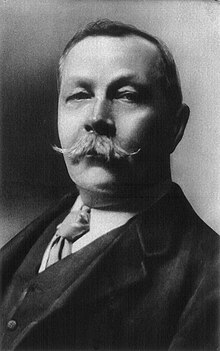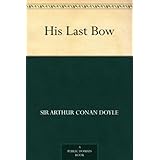About the Book: "His Last Bow", published in September 1917, is one of 56 short stories about Sherlock Holmes written by Sir Arthur Conan Doyle. It was first published in Strand Magazine, and, amongst six other stories, was collected in an anthology titled His Last Bow, also called Reminiscensces of Mr. Sherlock Holmes. The narration is in the third person, not, as usual, by Dr. Watson, and it is a spy story, rather than a murder mystery. Due to its portrayal of British and German spies, its publication during the First World War and its patriotic themes, the story has been interpreted as a propaganda tool intended to boost morale for British readers.
About the Author: Arthur Ignatius Conan Doyle was born on 22 May 1859 at 11 Picardy Place, Edinburgh, Scotland. From 1876 to 1881, he studied medicine at the University of Edinburgh, including a period working in the town of Aston (now a district of Birmingham) and in Sheffield, as well as in Shropshire at Ruyton-XI-Towns. While studying, Doyle began writing short stories. His earliest extant fiction, "The Haunted Grange of Goresthorpe", was unsuccessfully submitted to Blackwood's Magazine. His first published piece "The Mystery of Sasassa Valley", a story set in South Africa, was printed in Chambers's Edinburgh Journal on 6 September 1879. On 20 September 1879, he published his first non-fiction article, "Gelsemium as a Poison" in the British Medical Journal. In 1882 he joined former classmate George Turnavine Budd as his partner at a medical practice in Plymouth, but their relationship proved difficult, and Doyle soon left to set up an independent practice. Arriving in Portsmouth in June of that year with less than £10 (£900 today) to his name, he set up a medical practice at 1 Bush Villas in Elm Grove, Southsea. The practice was initially not very successful. While waiting for patients, Doyle again began writing stories and composed his first novels, The Mystery of Cloomber, not published until 1888, and the unfinished Narrative of John Smith, which would go unpublished until 2011. He amassed a portfolio of short stories including "The Captain of the Pole-Star" and "J. Habakuk Jephson's Statement", both inspired by Doyle's time at sea, the latter of which popularized the mystery of the Mary Celeste and added fictional details such as the perfect condition of the ship (which had actually taken on water by the time it was discovered) and its boats remaining on board (the one boat was in fact missing) that have come to dominate popular accounts of the incident. Doyle struggled to find a publisher for his work. His first significant piece, A Study in Scarlet, was taken by Ward Lock Co. on 20 November 1886, giving Doyle £25 for all rights to the story. The piece appeared later that year in the Beeton's Christmas Annual and received good reviews in The Scotsman and the Glasgow Herald. The story featured the first appearance of Watson and Sherlock Holmes, partially modeled after his former university teacher Joseph Bell. Doyle wrote to him, "It is most certainly to you that I owe Sherlock Holmes ... Round the center of deduction and inference and observation which I have heard you inculcate I have tried to build up a man." Robert Louis Stevenson was able, even in faraway Samoa, to recognize the strong similarity between Joseph Bell and Sherlock Holmes: "My compliments on your very ingenious and very interesting adventures of Sherlock Holmes. ... Can this be my old friend Joe Bell?" Other authors sometimes suggest additional influences—for instance, the famous Edgar Allan Poe character C. Auguste Dupin. A sequel to A Study in Scarlet was commissioned and The Sign of the Four appeared in Lippincott's Magazine in February 1890, under agreement with the Ward Lock company. Doyle felt grievously exploited by Ward Lock as an author new to the publishing world and he left them. Short stories featuring Sherlock Holmes were published in the Strand Magazine. Doyle first began to write for the 'Strand' from his home at 2 Upper Wimpole Street, now marked by a memorial plaque. In this period, however, Holmes was not his sole subject and in 1893, he collaborated with J.M. Barrie on the libretto of Jane Annie. Doyle was found clutching his chest in the hall of Windlesham Manor, his house in Crowborough, East Sussex, on 7 July 1930. He died of a heart attack at the age of 71. His last words were directed toward his wife: "You are wonderful." At the time of his death, there was some controversy concerning his burial place, as he was avowedly not a Christian, considering himself a Spiritualist. He was first buried on 11 July 1930 in Windlesham rose garden. He was later re-interred together with his wife in Minstead churchyard in the New Forest, Hampshire. Carved wooden tablets to his memory and to the memory of his wife are held privately and are inaccessible to the public. That inscription reads, "Blade straight / Steel true / Arthur Conan Doyle / Born May 22nd 1859 / Passed On 7th July 1930." The epitaph on his gravestone in the churchyard reads, in part: "Steel true/Blade straight/Arthur Conan Doyle/Knight/Patriot, Physician, and man of letters". Undershaw, the home near Hindhead, Haslemere, south of London, that Doyle had built and lived in between October 1897 and September 1907, was a hotel and restaurant from 1924 until 2004. It was then bought by a developer and stood empty while conservationists and Doyle fans fought to preserve it. In 2012 the High Court ruled that the redevelopment permission be quashed because proper procedure had not been followed. A statue honors Doyle at Crowborough Cross in Crowborough, where he lived for 23 years. There is also a statue of Sherlock Holmes in Picardy Place, Edinburgh, close to the house where Doyle was born.
My Review: In this story, we are on the eve of the First World War, and Von Bork, a German agent, is getting ready to leave England with his vast collection of intelligence, gathered over a four-year period. His wife and household have already left Harwich for Flushing in the Netherlands, leaving only him and his elderly housekeeper. Von Bork's diplomat friend, Baron von Herling, is impressed by his collection of vital British military secrets, and tells Von Bork that he will be received in Berlin as a hero. Von Bork indicates that he is waiting for one last transaction with his Irish-American informant, Altamont, who will arrive shortly with a rich treasure: naval signals.
Von Herling leaves. Von Bork then hears another car arriving. It is Altamont. By this time, the old housekeeper has turned her light off and retired. Altamont shows him a package.
Altamont proceeds to disparage Von Bork's safe, but Von Bork proudly says that nothing can cut through the metal, and that it has a double combination lock. He even tells Altamont the combination: "August 1914". Altamont then insinuates that German agents get rid of their informants when they are finished with them, naming several who have ended up in prison. Altamont's mistrust of Von Bork is evident in his refusal to hand over the package before he gets his check. Von Bork, for his part, wants to examine the document before handing over the check.
Altamont hands him the package. Upon opening it, he finds it to be a book called Practical Handbook of Bee Culture, hardly what he expected. Even less expected is the chloroform-soaked rag that is held in his face by Altamont a moment later. Altamont, it turns out, is none other than Sherlock Holmes, and the chauffeur who brought him is Dr. Watson. Now much older than in their heyday, they have nonetheless not only caught several spies (Holmes is actually responsible for the imprisoned agents of whom he spoke) in their return from retirement, but fed the Germans some thoroughly untrustworthy intelligence. Holmes has been on this case for two years, and it has taken him to Chicago, Buffalo, and Ireland, where he learnt to play the part of a bitter Irish-American, even gaining the credentials of a member of a secret society. He then identified the security leak through which British secrets were reaching the Germans.
The housekeeper was part of the plot too. The light that she switched off was the signal to Holmes and Watson that the coast was clear.
They drive Von Bork and all of the evidence to Scotland Yard.
At the end, it is revealed that Holmes has retired from active detective work. He spends his days beekeeping in the countryside and writing his definitive work on investigation.
The story is the last chronological installment of the series, though yet another collection (The Case Book of Sherlock Holmes), set before the story, was published four years later. In reference to the impending World War I, Holmes concludes,
"There's an east wind coming, Watson."
"I think not, Holmes. It is very warm."
"Good old Watson! You are the one fixed point in a changing age. There's an east wind coming all the same, such a wind as never blew on England yet. It will be cold and bitter, Watson, and a good many of us may wither before its blast. But it's God's own wind none the less, and a cleaner, better, stronger land will lie in the sunshine when the storm has cleared."
The patriotic sentiment of the above passage has been widely quoted, and was later used in the final scene of the Basil Rathbone film Sherlock Holmes and the Voice of Terror (1942), set in World War II, implied to have been a fictitious quote of Winston Churchill.
Another excellent plot, I recommend this book to the permanent library of any reader that appreciates a well written mystery story, mainly featuring Mr. Sherlock Holmes.
If you read this review, feel free to leave a comment!


No comments:
Post a Comment